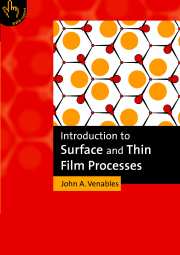Book contents
- Frontmatter
- Contents
- Preface
- Chapter 1 Introduction to surface processes
- Chapter 2 Surfaces in vacuum: ultra-high vacuum techniques and processes
- Chapter 3 Electron-based techniques for examining surface and thin film processes
- Chapter 4 Surface processes in adsorption
- Chapter 5 Surface processes in epitaxial growth
- Chapter 6 Electronic structure and emission processes at metallic surfaces
- Chapter 7 Semiconductor surfaces and interfaces
- Chapter 8 Surface processes in thin film devices
- Chapter 9 Postscript – where do we go from here?
- Appendix A Bibliography
- Appendix B List of acronyms
- Appendix C Units and conversion factors
- Appendix D Resources on the web or CD-ROM
- Appendix E Useful thermodynamic relationships
- Appendix F Conductances and pumping speeds, C and S
- Appendix G Materials for use in ultra-high vacuum
- Appendix H UHV component cleaning procedures
- Appendix J An outline of local density methods
- Appendix K An outline of tight binding models
- References
- Index
Chapter 7 - Semiconductor surfaces and interfaces
Published online by Cambridge University Press: 06 July 2010
- Frontmatter
- Contents
- Preface
- Chapter 1 Introduction to surface processes
- Chapter 2 Surfaces in vacuum: ultra-high vacuum techniques and processes
- Chapter 3 Electron-based techniques for examining surface and thin film processes
- Chapter 4 Surface processes in adsorption
- Chapter 5 Surface processes in epitaxial growth
- Chapter 6 Electronic structure and emission processes at metallic surfaces
- Chapter 7 Semiconductor surfaces and interfaces
- Chapter 8 Surface processes in thin film devices
- Chapter 9 Postscript – where do we go from here?
- Appendix A Bibliography
- Appendix B List of acronyms
- Appendix C Units and conversion factors
- Appendix D Resources on the web or CD-ROM
- Appendix E Useful thermodynamic relationships
- Appendix F Conductances and pumping speeds, C and S
- Appendix G Materials for use in ultra-high vacuum
- Appendix H UHV component cleaning procedures
- Appendix J An outline of local density methods
- Appendix K An outline of tight binding models
- References
- Index
Summary
This chapter gives a description of semiconductor surfaces, and the models used to explain them. Section 7.1 outlines ideas of bonding in elemental semiconductors, and these are used to discuss case studies of specific semiconductor surface reconstructions in section 7.2, building on the survey given in section 1.4. If you are not familiar with semiconductors and their structures, you will also need access to sources that describe the diamond, wurtzite and graphite structures, and which also describe the bulk band structures; these points can be explored via problem 7.1. It is also very helpful to have some prior knowledge of the terms used in covalent bonding, such as s and p bands, sp2 and sp3 hybridization. Section 7.3 describes stresses and strains at surfaces and in thin films, including the thermodynamic discussion delayed from section 1.1; the importance of such ideas in the growth of semiconductor device materials is discussed, especially those based on the elements germanium and silicon, with references also given to the 3–5 compound literature.
Structural and electronic effects at semiconductor surfaces
The first thing to realize is that the reconstructions of semiconductor surfaces are not, in general, simple. In section 1.4 reconstructions were introduced via the (relatively simple) Si(100) 2 × 1 surface. This introduced ideas of symmetry lowering at the surface, domains, and the association of domains with surface steps. At the atomic cell level we saw the formation of dimers, organized into dimer rows. If all this can happen on the simplest semiconductor surface, what can we expect on more complex surfaces? More importantly, how can we begin to make sense of it all?
- Type
- Chapter
- Information
- Introduction to Surface and Thin Film Processes , pp. 227 - 259Publisher: Cambridge University PressPrint publication year: 2000



